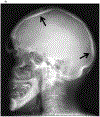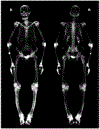Early-onset Paget's disease of bone in a Mexican family caused by a novel tandem duplication (77dup27) in TNFRSF11A that encodes RANK
- PMID: 31923705
- PMCID: PMC7179970
- DOI: 10.1016/j.bone.2020.115224
Early-onset Paget's disease of bone in a Mexican family caused by a novel tandem duplication (77dup27) in TNFRSF11A that encodes RANK
Abstract
Four heterozygous in-frame tandem duplications of different lengths in TNFRSF11A, the gene that encodes receptor activator of nuclear factor κB (RANK), constitutively activate RANK and lead to high turnover skeletal disease. Each duplication elongates the signal peptide of RANK. The 18-base pair (bp) duplication at position 84 (84dup18) causes familial expansile osteolysis (FEO), the 15-bp duplication at position 84 (84dup15) causes expansile skeletal hyperphosphatasia (ESH), the 12-bp duplication at position 90 (90dup12) causes panostotic expansile bone disease (PEBD), and the 27-bp duplication causes early-onset Paget's disease of bone (PDB2). The severity of the associated skeletal disease seems inversely related to the duplication's length. Additional 15- and 18-bp duplications of TNFRSF11A fit this pattern. Herein, we delineate the skeletal disease of a middle-aged man of Mexican descent who we found to harbor a novel 27-bp tandem duplication at position 77 (77dup27) of TNFRSF11A. His disorder shares features, particularly hand involvement, with the single Japanese (75dup27) and Chinese (78dup27) kindreds with PDB2 (PDB2Jpn and PDB2Chn, respectively). However, his distinct hearing loss developed later in adulthood compared to the other 27-bp families. He reported no morbidities during childhood, but in his late 20s developed unexplained tooth loss, low-trauma fractures, post-operative hypercalcemia, and painless enlargement of his fingers. Biochemical studies showed elevated serum alkaline phosphatase (ALP), bone-specific ALP, C-telopeptide, and osteocalcin consistent with rapid bone remodeling. Radiologic imaging revealed remarkably lucent bones with vertebral compression fractures, calvarial lucencies, and thinned long bone cortices. DXA showed extremely low bone mineral density. His disorder genetically and phenotypically fits best with PDB2 and can be called PDB2Mex.
Keywords: Bone markers; Bone turnover; Deafness; Early Paget's disease of bone; Fracturing; HIV infection; Hypercalcemia; Hyperphosphatasemia; NF-κB; Osteoclast; RANK; RANKL; TNFRSF11A; Tooth loss.
Published by Elsevier Inc.
Conflict of interest statement
Declaration of competing interest None.
Figures











References
-
- Martin TJ. Paracrine regulation of osteoclast formation and activity: milestones in discovery. J Musculoskelet Neuronal Interact. September 2004;4(3):243–53. - PubMed
-
- Albagha OME, Rojas J, Van’t Hof R, Dorin J, Ralston SH. A mouse model of early onset Paget’s disease of bone caused by an insertion mutation affecting the rank signal peptide. Calcified Tissue Int. 2007;80:S34–S.
Publication types
MeSH terms
Substances
Grants and funding
LinkOut - more resources
Full Text Sources
Medical

